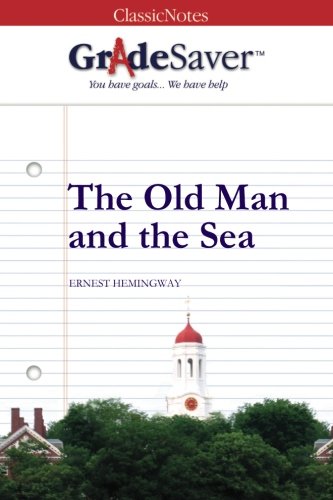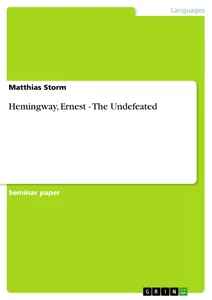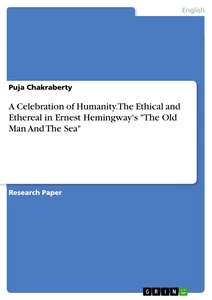Addeddate 2006-11-12 01:22:44 Call number 30256 Digitalpublicationdate 2005/06/28 Identifier firstfortyninest030256mbp Identifier-ark ark:/13960/t2v40km0k. Full Glossary for Hemingway's Short Stories; Essay Questions; Cite this Literature Note; Summary and Analysis The Doctor and the Doctor's Wife Summary. Adams hires two American Indians to cut some logs that broke free from a shipment bobbing downstream toward a large sawmill company. They are glad to make some extra money and are in a good.
- The Undefeated Ernest Hemingway Pdf
- The Undefeated Ernest Hemingway Pdf
- The Undefeated Hemingway Summary
Table of Contents
I Introduction

II. General Aspects
1. Biography of Ernest Hemingway
2. The Story of “The Undefeated“
III Main Part
1. The Main Theme
2. The Characterisation of Manuel Garcia
3. Pecularities of Hemingway’ s Style in “The Undefeated”
4. The Bullfight as Subject Matter
5. “The Undefeated“ as a Model for Hemingway’ s “The Old Man and the Sea“

IV Results
V Appendix
1. References
I. Introduction
Stories are the oldest forms of literature. They found their first expression in the classical tales of the Old Testament.
In recent times stories have taken a broader form than during the 18th and 19th century, when the literary form of the novel and poetry prevailed.
The 20th century has discovered new possibilities and in connection with it: a new interpretation of human character.
This essay deals with theme and structure of Ernest Hemingway’ s “The Undefeated”. In particular it describes the story and the main theme. Furthermore it gives a characterisation of Manuel Garcia, illustrates the pecularities of Hemingway’ s style and introduces the bullfight as subject matter. It deals with “The Undefeated“ as a model for Hemingway’ s “The Old Man and the Sea“.
The ideas of this essay are thematically linked. The second chapter looks at general aspects. It is an introduction into the biography of Ernest Hemingway and retells the story of “The Undefeated”. In the main part (third chapter) the themes mentioned above are examined. Results are drawn in the fourth chapter. After that in the appendix references are given.
II. General Aspects
1. Biography of Ernest Hemingway
Ernest Hemingway (1898-1961) was born in Oak Park, Illinois.
The Great Lakes, where he spent much of his early life, provided the settings for his early stories.
After he had graduated from High School he worked as a reporter for “The Kansas City Star” and volunteered for service in World War I. After the war he worked as a journalist in Chicago and Toronto. His first collection of stories “In Our Time” (1925)
consisted of 15 tales and related the experiences of the young Nick Adams in the Great Lakes region.
Hemingway’ s first novel “The Torrent of Spring” was published in 1926, quickly followed by the novel “The Sun also Rises”, which was also published in the same year.
In 1927 Hemingway published the collection “Men without Women” which contained “The Grand” and “The Undefeated”.

It is worth mentioning that the story “The Undefeated” , however, was first
published in “Quarterly”, a European magazine (Autumn- Winter 1925- 26)[1].
Later on Ernest Hemingway became one of the most famous American writers of the 20th century and his later books , e.g. A Farewell to Arms (1929), Death in the Afternoon (1932), Winner Take Nothing (stories, 1933), The Green Hills of Africa (1935), To Have and Have Not (1937), The Fifth Column and the First Forty-Nine Stories (1938), For Whom the Bell Tolls (1940), Across the River and Into the Trees (1950), The Old Man and the Sea (1952), A Moveable Feast (1964), Islands in the Stream (1970) have become very popular and many literary critiques and interpretations have been written about them except for “The Undefeated” which has had little attention in recent times.[2]
It is therefore time to leave the well trodden path of reviewing well-known books and to describe what “The Undefeated” is about and to fathom its deeper meaning.
2. The Story of “The Undefeated“
The first scene takes place in Don Miguel Retana’ s office, the walls of which are framed by photographs and bullfighting posters. Manual has come to see Retana to ask for work. He looks pale and does not look well because he has just come out of hospital. Yet he wants to remain a bullfighter. Retana offers to put Manual in a bullfight for the following night, “a noctural”. This is a bullfight which takes place in the evening and is not as important as the afternoon bullfight. Manuel is not willing to substitute for anybody else. Retana, on the other hand, would like to substitute him for Larita not only because he could get Manual cheaply but also because he would like to help Manul and to give him a fresh start. Retana offers Manuel only two hundred and fifty pesetas which is a small sum of money compared to the payment made to Villalta. Manual, however, knows that he cannot refuse since he is purely and simply too old. In order to have a chance, Manuel feels he will need to have a good “picador”.
After his meeting with Retana, Manuel goes to a café, where at one table four men play cards. Most of the men sit against the wall smoking; showing no interest in him.
Manuel wants to see Zurito. He drinks brandy and feels sleepy. He then leans forward and falls asleep. Zurito, the “picador”, is a big man with a heavy brown face. He has got big hands. He says to Manuel that he ought to get out of the business and stay out of the job as a bullfighter because he is really too old. Zurito wants Manuel to cut off his “coleta”, his pigtail. Manuel, however, asks for one last chance. In the end Zurito agrees to “pic” for Manuel with the condition that Manuel will quit, if he doesn’ t win the following night.
In an outside inner courtyard, they meet each other again. It is dark where they are standing. In the bullring, however, there is electric light. The stands are dark rising all the way round. Four picador have mounted their horses. Retana has not given them enough light to see the horses. Zurito is the only one who has got a good and solid horse. Two matadors Manuel and Hernandez stand together in front of their helpers. Hands up, swinging with the music they step out into the arena; the picadors are riding after. Bullfight servants and their mules follow. They bow before the President.
The bullfighters go their various ways. The picadors gallop around the ring. Zurito neither likes the fight nor the electric light; he has already fought in the hot afternoon for money. Then the bull comes out in a rush, charging at a gallop. In the first row of the seats the substitute bullfight critic of “El Heraldo” carelessly writes down a few notes. At that very moment the bull turns. Manuel pivots on his heels. The crowd shouts. As the bull sees a horse, he makes an attack on the horse’ s chest, gets under it, lifts it up and throws it on its back. Manuel shakes the cape at the bull. The bull looks at him, watching. Now Manuel swings the cape forward, steps aside, pivots. There is no applause. Nobody pays any attention. The critic of “El Heraldo” reaches for a bottle of champagne and writes down that Manuel gets no applause.
A trumpeter blows for the final act. This is about to begin when Manuel has to walk across the arena towards the President. With a memorized speech he formally gives the bull to the President and to the public of Madrid. The substitute bullfight critic of ”El Heraldo” decides that it is not worthwhile to write a long story, he is going to finish in the office. Manuel walks towards the bull who is watching Manuel steadily. Manuel is white and sweating, unsure of what is about to come. He is kneeling in the centre of the ring. The bull charges again, now Manuel brings around the “muleta” in a half-circle that pulls the bull to his knees. Now finally there is a first sign of applause from the dark arena.
All of a sudden and without warning, Manuel feels a blow and he is flung into the air. His sword flies out of his hand. Manuel is lying on the ground. He can do nothing but kick at the bull’ s muzzle with his feet. Then the bull has gone over Manuel in a rush. Fortunately he is not stepping on him. Manuel stands up and is handed a sword. Funnily enough for the crowd, a canvas is hanging from the bull’ s damaged horn. The crowd laugh. Again Manuel feels a blow and feels himself being thrown back. The bull is on top of him, he pushes and knocks him down. A horn drives through his sleeves. Manuel gets up and runs forward to get a new sword. Cushions are thrown down into the arena out of the dark, one hits him.
Manuel steps close to the bull and pushes the sharp point of his muleta into the bull’ s muzzle. The bull knocks Manuel down again. Hernandez asks him to give up this fight and to go to the hospital. But Manuel does not want to go the infirmary straight away. On the contrary, with all his might he throws himself onto the bull. He hits him and feels his sword go straight in. The bull is dead.
Helpers carry Manuel across the ring to the hospital. On the operating table he feels light shining in his eyes. Zurito and Retana are next to him. They are about to cut off his “coleta”. But then Manuel opens his eyes and looks at Zurito:
” ”Wasn’t I going good, Manos?” he asked , for confirmation.

“Sure”, said Zurito. “You were going great.“”[3]
Zurito who has been about to cut off Manuel’ s coleta now says:
” ”That’ s all right,”(…). ”I won’t do it. I was joking.”“[4]
III. Main Part
1. The Main Theme
“The Undefeated” has one main theme: Man is at odds with the World and faces his difficulties with courage.
Manuel has been cast into a world which refuses his participation. He is stereotyped as someone ” of the old days”[5]. But Manuel does not want to be a victim. He wants to prove his ability, “to stick with it”[6]. He wants to show that he is still a champion, “a bullfighter”[7]. He asks for “an even break”[8]. Manuel is “the archetypal Hemingway hero”[9]. He is too old for his profession and too weak because of his recent hospitalisation. He is poorly paid and a last-minute substitute. He performs for an audience that does not understand his art. To follow the comic bullfights , “the Charlie Chaplins”[10] is humiliating. Retana’ s men degrade him. “”If it was Belmonte doing that stuff, they’d go crazy (…)”“[11].
[...]
[1] Cf. Smith, Paul, A Reader’ s Guide to the Short Stories of Ernest Hemingway, Boston (Massachusetts) 1989, p. 103.
[2] Cf. article “Hemingway, Ernest Miller”, in: The Encyclopedia Americana. The International Reference Work Volume XIV, New York (New York) among others 1958, p. 88.
[3] Hemingway, Ernest, The Undefeated, in: Hemingway, Ernest, The Complete Short Stories of Ernest Hemingway. The Finca Vigia Edition, New York (New York) 1987, p. 205.
[4] Ib. p. 204.
[5] Ib. p. 185.

[6] Ib. p.189.
[7] Ib. p.184.
[8] Ib. p.186.
[9] Brenner, Gerry, Concealments in Hemingway’ s Works, Columbus (Ohio) 1983, p. 101.
The Undefeated Ernest Hemingway Pdf
[10] Hemingway, Ernest, The Undefeated, in: Hemingway, Ernest, The Complete Short Stories of Ernest Hemingway. The Finca Vigia Edition, New York (New York) 1987, p. 187, p. 190.
[11] Ib. p. 200.
'The Undefeated' is a short story by Ernest Hemingway featured in Hemingway's 1927 story collection, Men Without Women.[1] The story deals with a bullfighter who attempts to work his way back into fame following an injury.
Plot[edit]
The main character, Manuel Garcia, is a bullfighter who recently got out of the hospital and is now looking for work. After an old promoter, Retana, hires him for a 'nocturnal' fight on the following evening, he enlists the help of an old friend to be his picador. Although Zurito, his picador, strongly discourages Manuel, Manuel proceeds with the fight and is injured while fighting his first bull of the night, ending up back in the infirmary at the end of the story.
The Undefeated Ernest Hemingway Pdf
References[edit]
- ^MacDonald, Scott (1972). 'Implications of Narrative Perspective in Hemingway's 'The Undefeated''. The Journal of Narrative Technique. 2 (1): 1–15. ISSN0022-2925. JSTOR30225265.
The Undefeated Hemingway Summary
